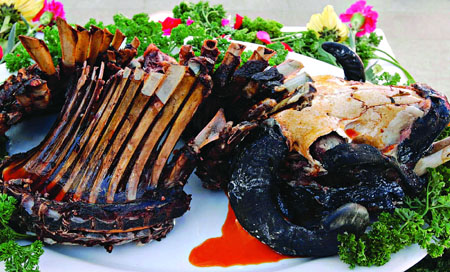|
Tibetan people have their own unique food structure and catering customs. Zanba, butter, tea and beef & mutton are known as the four treasures of the Tibet diet. There are also the barley wine and various kinds of dairy products.
Tibetan Food
Tibetan food has a long history and is rich in variety. It is grouped into three major kinds, namely, staple food, dish and soup. Tibetan food pays close attention to a light taste. Peppery seasoning is normally not used, only salt and garlic.

Tibetan roasted mutton chops are very tasty.
Zanba is the staple food of the Tibetan people and is simple. Mill the parched highland barley grains into flour, which is zanba. When eating, put the zanba into a bowl, add a little butter tea to it, and mix and knead into a dumpling.
Air-dried meat is a unique food in Tibet. When the temperature falls below zero at the end of the year, slit the quality beef and then hang it in a windy place to dry. It can be eaten in the following February or March, the crisp meat having a unique taste.
There are numerous ways of cooking the food at a Tibetan-style feast, along with the means of holding a feast. In traditional society, the social status of guests was a determinant of the style of feast. There are both vegetable and meat-based feasts in Tibet.
Tibetan people have many taboos regarding meat. Generally, they eat only beef and mutton, and never consume horse, donkey, mule and dog meat. Some people even do not eat chicken, pork and eggs. Young people in the cities and towns consume fish, shrimp, snake, eel and other seafood, but the masses in the farming and pasturing areas never touch them.
With the improvement of the social economy and cultural life, the technique of cooking Tibetan dishes and the forms of taking the meal have been improved and enriched.
Wine Culture
Tibetan barley wine is brewed from fermented barley grown in the highlands, with lower alcohol content. Men and women of all ages like to drink it and it is indispensable during happy events and festivals.

Toasting qingke barley wine to people at the Spring Ploughing Ceremony
There is a rich etiquette and many social customs associated with drinking wine. Every time new wine is brewed, it is first offered to the gods and then to toast the oldest members of the family according to the ancient precept that "the old and young should observe order". At last, the family members can drink their fill. During a festival, wedding feast, or gathering of many people, the first toast is offered to the sainted elder present and then passes around clockwise. The toaster should raise the wine cup to about the height of his head with both hands in offering it to the person accepting the toast. The other person then takes over the cup with both hands, dips his or her right ring finger into the wine while holding the cup in the other hand and flicks the wine drops on the finger into the air. The movement is repeated three times to show respect to heaven, earth and the deities respectively. Sometimes, the person will make a congratulatory speech in a light tone before drinking.
When drinking at a gathering, singing is absolutely necessary. Tibetan toast songs are melodious and fair-sounding and express blessings and admiration. At a general feast, the host and hostess will sing the toast song. On very grand occasions, there are girls especially in charge of toasting others. The beautifully-dressed girl, singing the enchanting toast songs, will persuade each of the guests to drink in turn until all are drunk.
Tibetan Tea Culture
Butter tea is an indispensable drink in Tibetan life. The butter is the cream extracted usually from cow or sheep's milk, but the golden yellow butter extracted from yak milk in summer is the best; that extracted from sheep's milk is white. When drinking tea, the Tibetan people pay attention to rank according to age, and the order of master and guest. Guests cannot drink too fast. Generally speaking, drinking three bowls is the most propitious.
|





